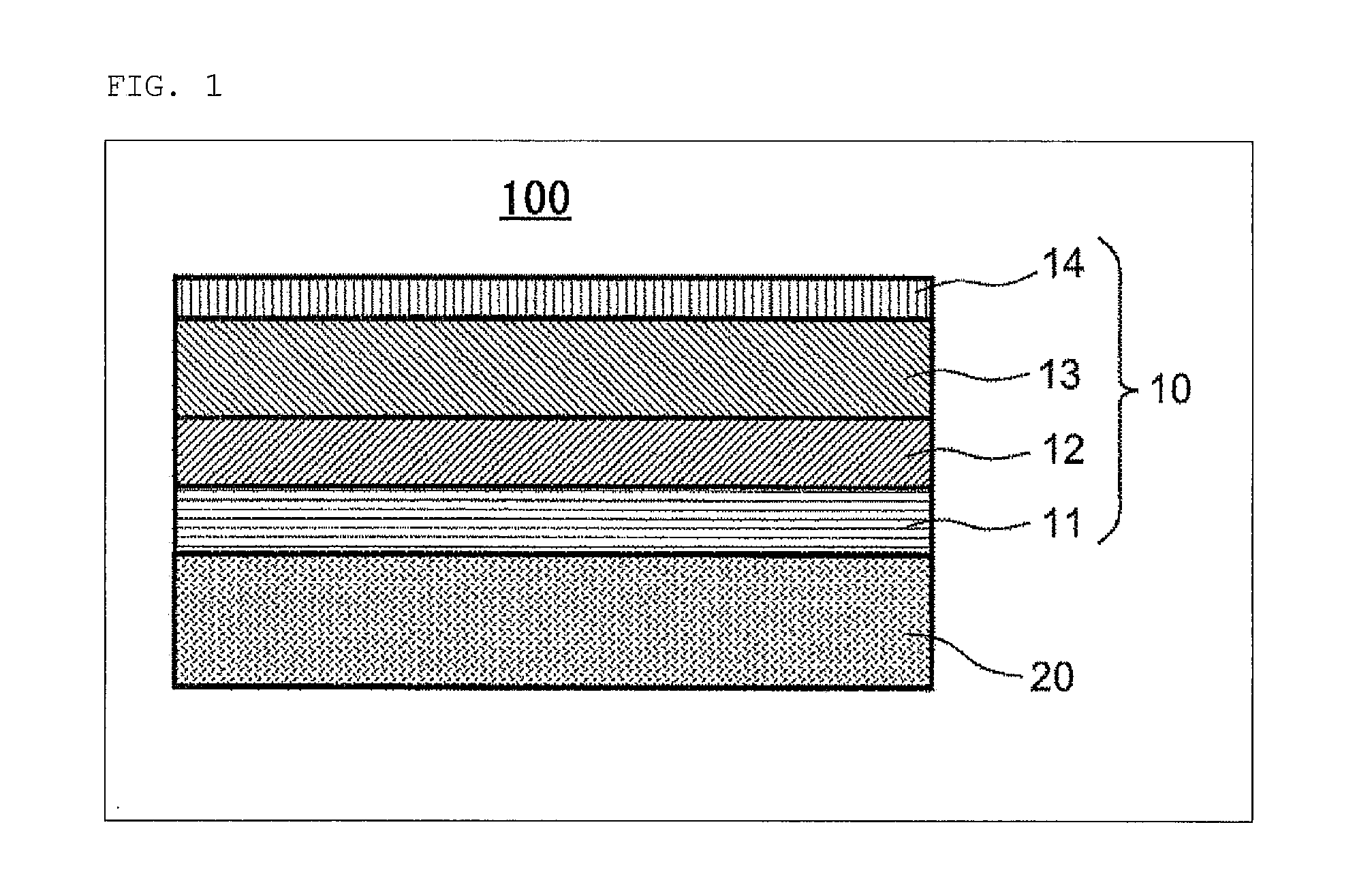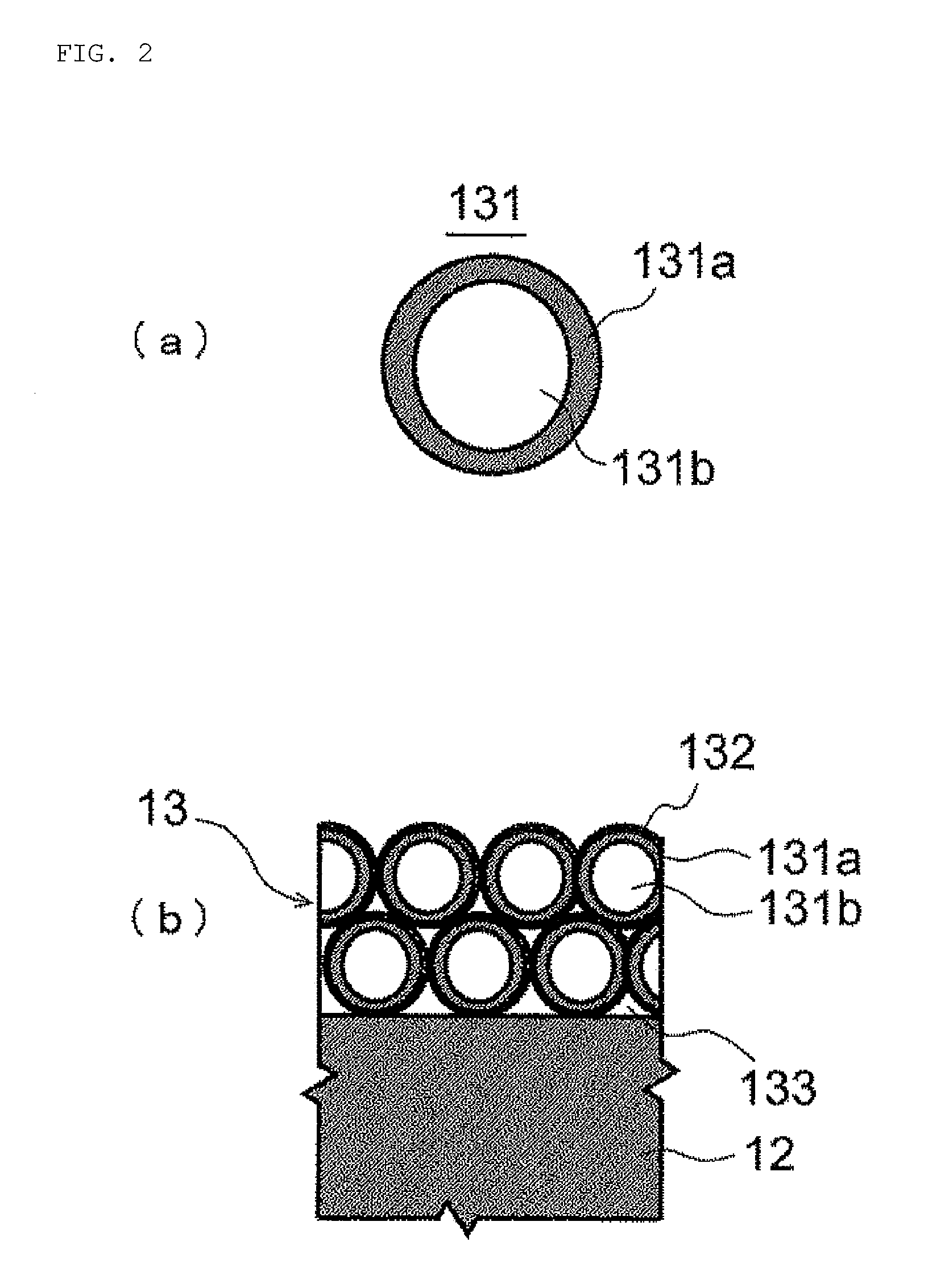Anti-Reflection Coat and Optical Device
a technology of anti-reflection coat and optical device, which is applied in the direction of coating, instruments, nanotechnology, etc., can solve the problems of difficult to achieve a further lower refractive index of film formed by vapor deposition method, difficult to accurately form an anti-reflection coat on the surface of a lens having a large curvature, and a curvature. , to achieve the effect of excellent durability and stability, excellent appearance, and excellent durability
- Summary
- Abstract
- Description
- Claims
- Application Information
AI Technical Summary
Benefits of technology
Problems solved by technology
Method used
Image
Examples
example 1
[0098]In Example 1, a lens (refractive index n=1.86) made of optical glass FDS90 manufactured by HOYA Corp. was used as the substrate 20. On the surface of the substrate 20, an anti-reflection coat 10 having a multilayer structure shown in Table 1 was provided. Specifically, the anti-reflection coat 10 was prepared as follows. First, an inorganic base layer 11 was formed on the surface of the substrate 20 by using the ARES 1510 manufactured by Leybold Optics GmbH according to a vacuum vapor deposition method. As shown in Table 1, the inorganic base layer 11 was made to have a two-layer structure by sequentially stacking an extremely thin film of Al2O3 (refractive index n=1.63) and an extremely thin film of SiO2 (n=1.48) on the surface of the substrate 20. The thicknesses of the layers constituting the inorganic base layer 11 are as shown in Table 1. In the present specification, a just “SiO2” is general silica without hollow structure.
[0099]By the way, an intermediate layer 12 compo...
example 2
[0101]In Example 2, an intermediate layer 12 composed of an organosilicon oxide film was formed by using tetramethylsilane (TMS). Layer structure of the anti-reflection coat 10 and thickness of each layer were set as shown in Table 2. The inorganic base layer 11 and the low refractive index layer 13 were each formed in almost the same manner as in Example 1, and the intermediate layer 12 was formed as follows.
[0102]By the way, in the formation of the intermediate layer 12, an organosilicon oxide film can be deposited on the surface of the inorganic base layer 11 in almost the same manner as in Example 1 except that tetramethylsilane is used as the thin film-constituting raw material. In the process, the refractive index of the prepared organosilicon oxide film can be appropriately managed within a range from 1.40 to 1.65, by arranging the gas flow rates and the discharge conditions within a flow rate range of the tetramethylsilane gas introduced into the chamber from 10 sccm to 200 ...
example 3
[0103]In Example 3, an anti-reflection coat 10 was prepared in the same manner as in Example 1 except that layer structure and thickness of each layer were set as shown in Table 3.
TABLE 3RefractivePhysical filmMaterialindexthickness (nm)substrateFDS901.86—InorganicAl2O31.6311base layerTiO2 + ZrO22.1029Al2O31.6330TiO2 + ZrO22.1031Al2O31.6371TiO2 + ZrO22.103SiO21.4835IntermediateOrganosilicon1.541layeroxide (HMDSO)LowHollow silica1.20104refractiveparticle + acrylicindex layerresin
PUM
| Property | Measurement | Unit |
|---|---|---|
| refractive index | aaaaa | aaaaa |
| refractive index | aaaaa | aaaaa |
| particle size | aaaaa | aaaaa |
Abstract
Description
Claims
Application Information
 Login to View More
Login to View More - R&D
- Intellectual Property
- Life Sciences
- Materials
- Tech Scout
- Unparalleled Data Quality
- Higher Quality Content
- 60% Fewer Hallucinations
Browse by: Latest US Patents, China's latest patents, Technical Efficacy Thesaurus, Application Domain, Technology Topic, Popular Technical Reports.
© 2025 PatSnap. All rights reserved.Legal|Privacy policy|Modern Slavery Act Transparency Statement|Sitemap|About US| Contact US: help@patsnap.com



